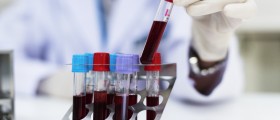
Human serum is, essentially, the portion of the blood not involved in clotting, and it is packed full of different proteins. These proteins perform many functions. The most simple as well as most abundant protein present in serum is albumin, which makes up nearly half of its volume. Apart from albumin, serum also contains globulin and fibrinogen. The testing of serum protein levels includes measuring the total proteins, measuring albumin, globulin and fibrinogen levels, and measuring the albumin to globulin ratio.
What are globulins, and what different kinds exist?
All serum globulins are classified according to protein electrophoresis into four categories: alpha 1 globulins, alpha 2 globulins, beta globulins and gamma globulins. One particular group of gamma globulins are called immunoglobulins, which people who are not medical professionals will mainly know as antibodies. Their role is to fight pathogens in the blood stream.
Each of these globulins can be easily measured in laboratory tests, and if a patient has a certain medical condition, the levels of all types of globulins will change and either increase or decrease. Mature B lymphocytes (plasma cells) produce antibodie,s and the liver is in charge of the production of the majority of other proteins in the alpha and beta fraction.
What do Changes in Globulin Levels Mean?
The normal range of globulins, seen in healthy individuals, is 2.3 to 3.5 gm/dL. The normal alpha globulin range is 0.2 to 0.3 g/L, while the optimal beta globulin range is 0.7 to 1.0 g/L. The level of globulins can increase or fall below the optimal range for a wide number of specific reasons.
High globulin levels are usually associated with chronic inflammatory diseases such as tuberculosis and syphilis. Furthermore, the level of globulins is commonly elevated in patients with multiple myeloma, carcinoid syndrome, leukemia and Waldenstrom's macroglobulinemia. Autoimmune diseases such as systemic lupus erythematosus, rheumatoid arthritis, and many more are always accompanied by elevated levels of globulins. High levels of globulins also occur in people suffering from different liver and kidney disorders and are also a characteristic of chronic infections caused by parasites, viruses, or bacteria.
On the other hand, low globulin levels may point to the presence of hepatic and kidney dysfunction, various neoplasms, acute hemolytic anemia, hypogammaglobulinemia or agammaglobulinemia.
Albumin/Globulin Ratio
The optimal albumin/globulin range is 1.7 to 2.2 with a ratio of 2:1. In some medical conditions, this ratio can be altered and according to the change the doctor may gain insights into the possible underlying disease processes patients may be suffering from. For example, a decreased albumin/globulin ratio points to the presence of liver dysfunction. On the other hand, a increased albumin/globulin ratio is a characteristic of high protein and low carbohydrate diet, hypothyroidism, hypogammaglobulinemia and glucocorticoid excess.
A general increase of protein levels can be caused by certain medications such as anabolic steroids, androgens, growth hormone, insulin and progesterone. On the other side, estrogen, medications that cause liver toxicity and oral contraceptives can be responsible for a general decrease in protein levels. It is essential to establish the exact cause of all the previously mentioned changes and treat a patient accordingly. Even once the treatment has started regular testing of serum proteins can aid the process as it can offer insights into the success or failure of the treatment.

















Your thoughts on this
Loading...